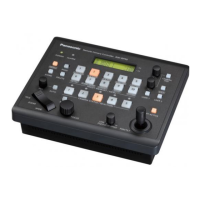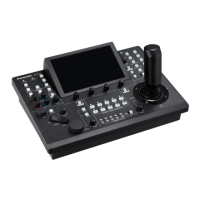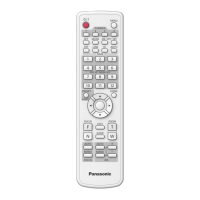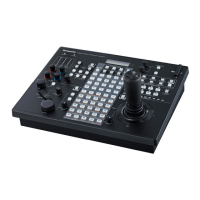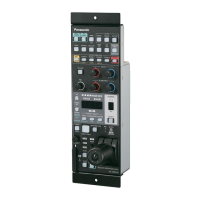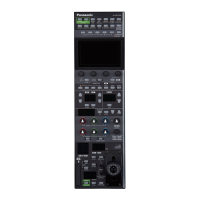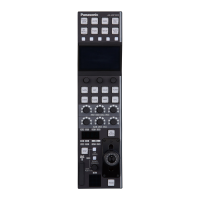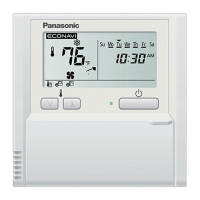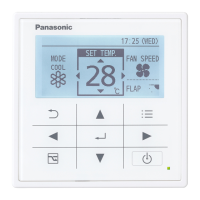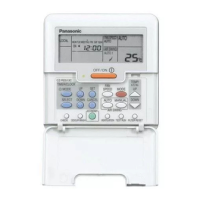Do you have a question about the Panasonic AW-RP50N and is the answer not in the manual?
Provides a general introduction to the remote camera controller and its capabilities.
Lists trademarks and registered trademarks relevant to the unit and software.
Outlines copyright and licensing restrictions for the unit's software.
Indicates where to find the unit's name, model number, and electrical ratings.
States Panasonic's warranty limitations and disclaims liability for certain damages.
Highlights security risks and provides precautions for network connections.
Step-by-step guide to powering on a single remote camera.
Instructions for powering on multiple remote cameras simultaneously.
Procedure to power on all connected remote cameras at once.
Guide to powering on cameras belonging to a specific group.
Step-by-step guide to powering off a single remote camera.
Instructions for powering off multiple remote cameras simultaneously.
Procedure to power off all connected remote cameras at once.
Guide to powering off cameras belonging to a specific group.
Detailed steps for saving camera positions and settings into memory.
Instructions on how to recall and apply stored preset memory data.
Procedure for removing stored preset memory data.
Adjusts the camera's gain level to compensate for lighting conditions.
Adjusts the black level (pedestal) for better visibility of dark image parts.
Adjusts the camera's white balance for accurate color reproduction under different lighting.
Guides on using the automatic white balance adjustment feature.
Details on manually adjusting R and B gain for white balance.
Explains the ATW function for continuous white balance compensation.
Explains the importance and procedure for setting black balance.
Guides on using the automatic black balance adjustment feature.
Details on manually adjusting R and B pedestal for black balance.
Instructions for selecting shutter mode and speed.
Adjusts image sharpness and detail level.
Selects appropriate shooting modes based on conditions.
Switches output between camera images and color bars.
Summarizes menu operations for different camera models using OSD buttons and dials.
Explains how to assign functions to USER buttons for quick access.
Configures tally ON/OFF for remote cameras based on network requests.
General overview of setting various camera operations.
Adjusts preset movement speed and defines actions upon preset execution.
Overview of controlling connected peripheral devices.
Disables operation of specific buttons like OSD and PRESET MEMORY/MENU.
Configures the direction of movement for pan, tilt, zoom, and focus.
Slows down pan/tilt operations for easier tele shooting positioning.
Switches dial control between focus and iris functions.
Selects PTZ speed targets and adjusts PAN/TILT lever inclination.
Sets the speed for moving to preset memory positions.
Resets cameras to their default home position.
Adjusts speed uniformly for PTZ operations.
Sets upper, lower, left, and right limits for camera movement.
Details specific controls for wiper, ND filter, heater/fan, lamp, defroster.
Ensures smooth zoom initiation by adjusting start speed.
Assigns presets for external control via TALLY/GPI input.
Allows adjustment of the LCD panel's backlight brightness.
Configures network settings for linking the unit with a switcher.
Sets the IP address of the connected switcher.
Establishes the link connection between the unit and switcher.
Establishes the link between the unit and switcher.
Correlates camera output with switcher input for notification.
General settings for controlling the linked switcher.
Configures bus switching for material transfer.
Sets the material (AUX, PVW, etc.) to be sent to the switcher.
Displays camera icons on the switcher's multi-view display.
Switches AUX bus output based on focus assist status.
Enables/disables tally information instructions sent over the network.
Uses the PAN/TILT lever for switcher control.
Configures remote camera information display on the monitor OSD.
Enables/disables all information displays for remote cameras.
Configures display of video format, camera name, scene, gain, shutter, iris, filter, alarm.
Checks the unit's power supply alarm status.
Checks alarm statuses of assigned remote cameras.
Returns all unit settings to factory defaults.
Returns only SETUP menu settings to factory defaults.
Describes tally input/output and GPI input/output ports and their functions.
Provides instructions for installing the setup software on a computer.
Configures IP addresses for cameras and switcher using the software.
Explains various elements of the software's setting tab.
Automates setting IP addresses for cameras and switcher.
Modifies camera numbers within the software.
Assigns camera numbers to switcher input connectors.
Manually changes IP addresses of devices.
Resets IP addresses to default values.
Loads network environment settings from a file.
Saves current network environment settings to a file.
Saves log files for troubleshooting.
Views network environment information of other AW-RP50 units.
Details settings for Gain and Pedestal adjustments.
Details settings for R/B Gain adjustments.
Details settings for R/B Pedestal adjustments.
Details settings for White Balance and Black Balance.
Details settings for Shutter Speed and Mode.
Details settings for image detail and sharpness.
Details settings for Scene/Mode selection.
Details settings for Camera Group, Power, and Tally.
Details various setup menu items including USER, SW LINK, SW DISP, OPERATE, PRESET.
Details FUNCTION, PTZ ADJ, GPI, LCD BL, MENU CTL sub-items.
Details SYSTEM menu items like CAMERA CTL, CAM ASSIGN, SW CTL, AUTO SET IP, NETWORK, CAM IP ADR, CAM PORT, SW IP ADR, ALARM, INITIALIZE, VERSION.
Provides a general introduction to the remote camera controller and its capabilities.
Lists trademarks and registered trademarks relevant to the unit and software.
Outlines copyright and licensing restrictions for the unit's software.
Indicates where to find the unit's name, model number, and electrical ratings.
States Panasonic's warranty limitations and disclaims liability for certain damages.
Highlights security risks and provides precautions for network connections.
Step-by-step guide to powering on a single remote camera.
Instructions for powering on multiple remote cameras simultaneously.
Procedure to power on all connected remote cameras at once.
Guide to powering on cameras belonging to a specific group.
Step-by-step guide to powering off a single remote camera.
Instructions for powering off multiple remote cameras simultaneously.
Procedure to power off all connected remote cameras at once.
Guide to powering off cameras belonging to a specific group.
Detailed steps for saving camera positions and settings into memory.
Instructions on how to recall and apply stored preset memory data.
Procedure for removing stored preset memory data.
Adjusts the camera's gain level to compensate for lighting conditions.
Adjusts the black level (pedestal) for better visibility of dark image parts.
Adjusts the camera's white balance for accurate color reproduction under different lighting.
Guides on using the automatic white balance adjustment feature.
Details on manually adjusting R and B gain for white balance.
Explains the ATW function for continuous white balance compensation.
Explains the importance and procedure for setting black balance.
Guides on using the automatic black balance adjustment feature.
Details on manually adjusting R and B pedestal for black balance.
Instructions for selecting shutter mode and speed.
Adjusts image sharpness and detail level.
Selects appropriate shooting modes based on conditions.
Switches output between camera images and color bars.
Summarizes menu operations for different camera models using OSD buttons and dials.
Explains how to assign functions to USER buttons for quick access.
Configures tally ON/OFF for remote cameras based on network requests.
General overview of setting various camera operations.
Adjusts preset movement speed and defines actions upon preset execution.
Overview of controlling connected peripheral devices.
Disables operation of specific buttons like OSD and PRESET MEMORY/MENU.
Configures the direction of movement for pan, tilt, zoom, and focus.
Slows down pan/tilt operations for easier tele shooting positioning.
Switches dial control between focus and iris functions.
Selects PTZ speed targets and adjusts PAN/TILT lever inclination.
Sets the speed for moving to preset memory positions.
Resets cameras to their default home position.
Adjusts speed uniformly for PTZ operations.
Sets upper, lower, left, and right limits for camera movement.
Details specific controls for wiper, ND filter, heater/fan, lamp, defroster.
Ensures smooth zoom initiation by adjusting start speed.
Assigns presets for external control via TALLY/GPI input.
Allows adjustment of the LCD panel's backlight brightness.
Configures network settings for linking the unit with a switcher.
Sets the IP address of the connected switcher.
Establishes the link connection between the unit and switcher.
Establishes the link between the unit and switcher.
Correlates camera output with switcher input for notification.
General settings for controlling the linked switcher.
Configures bus switching for material transfer.
Sets the material (AUX, PVW, etc.) to be sent to the switcher.
Displays camera icons on the switcher's multi-view display.
Switches AUX bus output based on focus assist status.
Enables/disables tally information instructions sent over the network.
Uses the PAN/TILT lever for switcher control.
Configures remote camera information display on the monitor OSD.
Enables/disables all information displays for remote cameras.
Configures display of video format, camera name, scene, gain, shutter, iris, filter, alarm.
Checks the unit's power supply alarm status.
Checks alarm statuses of assigned remote cameras.
Returns all unit settings to factory defaults.
Returns only SETUP menu settings to factory defaults.
Describes tally input/output and GPI input/output ports and their functions.
Provides instructions for installing the setup software on a computer.
Configures IP addresses for cameras and switcher using the software.
Explains various elements of the software's setting tab.
Automates setting IP addresses for cameras and switcher.
Modifies camera numbers within the software.
Assigns camera numbers to switcher input connectors.
Manually changes IP addresses of devices.
Resets IP addresses to default values.
Loads network environment settings from a file.
Saves current network environment settings to a file.
Saves log files for troubleshooting.
Views network environment information of other AW-RP50 units.
Details settings for Gain and Pedestal adjustments.
Details settings for R/B Gain adjustments.
Details settings for R/B Pedestal adjustments.
Details settings for White Balance and Black Balance.
Details settings for Shutter Speed and Mode.
Details settings for image detail and sharpness.
Details settings for Scene/Mode selection.
Details settings for Camera Group, Power, and Tally.
Details various setup menu items including USER, SW LINK, SW DISP, OPERATE, PRESET.
Details FUNCTION, PTZ ADJ, GPI, LCD BL, MENU CTL sub-items.
Details SYSTEM menu items like CAMERA CTL, CAM ASSIGN, SW CTL, AUTO SET IP, NETWORK, CAM IP ADR, CAM PORT, SW IP ADR, ALARM, INITIALIZE, VERSION.
| Compatibility | Panasonic PTZ Cameras |
|---|---|
| Power | 12 VDC |
| User Interface | Joystick |
| Power Supply | 12 VDC |
| Connectors | RJ-45 |
| Operating Temperature | 0 to 40 °C |
| Storage Temperature | -20 to 50°C |
